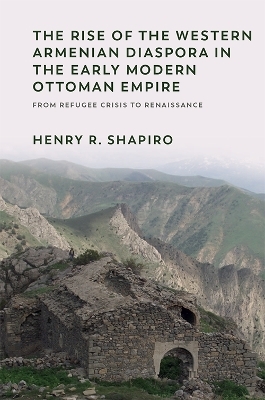
The Rise of the Western Armenian Diaspora in the Early Modern Ottoman Empire
From Refugee Crisis to Renaissance in the 17th Century
Seiten
2023
Edinburgh University Press (Verlag)
978-1-4744-7961-5 (ISBN)
Edinburgh University Press (Verlag)
978-1-4744-7961-5 (ISBN)
Explores how mass migration and a refugee crisis transformed Armenian culture in the 17th-century Ottoman Empire
Provides the first English book on Armenian cultural history in the early modern Ottoman Empire
Utilises original research on Armenian manuscripts and Ottoman Turkish archives
Resonates with contemporary concerns about climate change, migration and refugees
Includes 20 black and white photographs of Armenian ruins, documents and historical sites
The Rise of the Western Armenian Diaspora in the Early Modern Ottoman Empire traces how Armenian migrants changed the demographic and cultural landscape of Istanbul and Western Anatolia in the course of the 17th century. During the centuries that followed, Ottoman Armenian merchants, financiers (sarraf), authors, musicians, translators, printers and bureaucrats would play key roles in Ottoman trade, art and even governance that is, in most spheres of the empire's economic and cultural life. This book shows how that cosmopolitan world came into being.
Using both Ottoman Turkish and little-known Armenian sources, Henry Shapiro provides the first systematic study of Armenian population movements that resulted in the cosmopolitan remaking of Istanbul. Part I documents the Great Armenian Flight, showing how the global crisis of the 17th century (war, climate change, famine) impacted the historical Armenian population centres of the Caucasus and Eastern Anatolia and led to mass migrations and resettlement in Western Anatolia, Istanbul and Thrace. In Part II, Shapiro links this history of migration and the refugee crisis with the development of intellectual and cultural life in Istanbul and Western Anatolia: the rise of the Western Armenian Diaspora.
Provides the first English book on Armenian cultural history in the early modern Ottoman Empire
Utilises original research on Armenian manuscripts and Ottoman Turkish archives
Resonates with contemporary concerns about climate change, migration and refugees
Includes 20 black and white photographs of Armenian ruins, documents and historical sites
The Rise of the Western Armenian Diaspora in the Early Modern Ottoman Empire traces how Armenian migrants changed the demographic and cultural landscape of Istanbul and Western Anatolia in the course of the 17th century. During the centuries that followed, Ottoman Armenian merchants, financiers (sarraf), authors, musicians, translators, printers and bureaucrats would play key roles in Ottoman trade, art and even governance that is, in most spheres of the empire's economic and cultural life. This book shows how that cosmopolitan world came into being.
Using both Ottoman Turkish and little-known Armenian sources, Henry Shapiro provides the first systematic study of Armenian population movements that resulted in the cosmopolitan remaking of Istanbul. Part I documents the Great Armenian Flight, showing how the global crisis of the 17th century (war, climate change, famine) impacted the historical Armenian population centres of the Caucasus and Eastern Anatolia and led to mass migrations and resettlement in Western Anatolia, Istanbul and Thrace. In Part II, Shapiro links this history of migration and the refugee crisis with the development of intellectual and cultural life in Istanbul and Western Anatolia: the rise of the Western Armenian Diaspora.
Henry R. Shapiro is currently a postdoctoral researcher at the Polonsky Academy for Advanced Study in the Humanities and Social Sciences at the Van Leer Jerusalem Institute, and he also teaches courses on early modern Islamic history and the Classical Armenian language at the Hebrew University of Jerusalem. He specializes on the histories of non-Muslims in the early modern Islamic empires, particularly in the Ottoman Empire. Shapiro completed his PhD in History at Princeton University, his MA at Sabanc? University, an MDiv at Harvard Divinity School, and his BA in Classics at Brown University. He has published articles in the Journal of Early Modern History and Iranian Studies.
| Erscheinungsdatum | 21.10.2023 |
|---|---|
| Reihe/Serie | Non-Muslim Contributions to Islamic Civilisation |
| Zusatzinfo | 20 B/W illustrations 20 black and white illustrations and 3 maps |
| Verlagsort | Edinburgh |
| Sprache | englisch |
| Maße | 156 x 234 mm |
| Themenwelt | Geisteswissenschaften ► Geschichte ► Allgemeine Geschichte |
| Geisteswissenschaften ► Geschichte ► Regional- / Ländergeschichte | |
| Geschichte ► Teilgebiete der Geschichte ► Kulturgeschichte | |
| Religion / Theologie ► Christentum ► Kirchengeschichte | |
| Sozialwissenschaften ► Ethnologie | |
| Sozialwissenschaften ► Soziologie | |
| ISBN-10 | 1-4744-7961-8 / 1474479618 |
| ISBN-13 | 978-1-4744-7961-5 / 9781474479615 |
| Zustand | Neuware |
| Informationen gemäß Produktsicherheitsverordnung (GPSR) | |
| Haben Sie eine Frage zum Produkt? |
Mehr entdecken
aus dem Bereich
aus dem Bereich
Die Revolution des Gemeinen Mannes
Buch | Softcover (2024)
C.H.Beck (Verlag)
CHF 16,80
vom Mittelalter bis zur Gegenwart
Buch | Softcover (2024)
C.H.Beck (Verlag)
CHF 16,80


